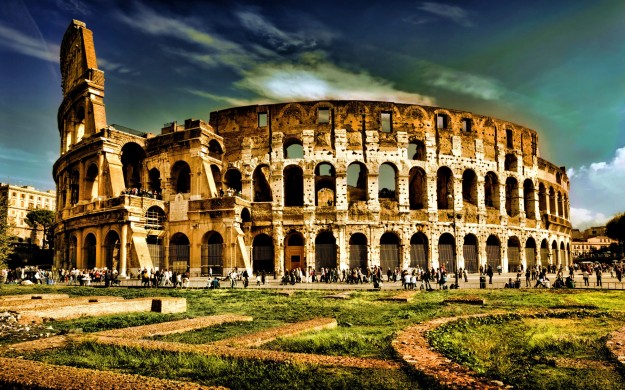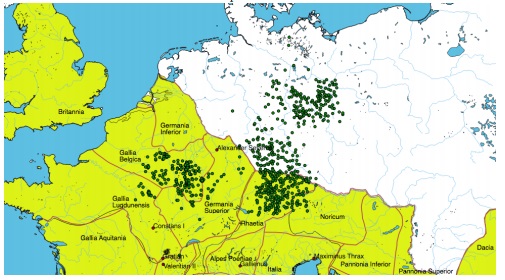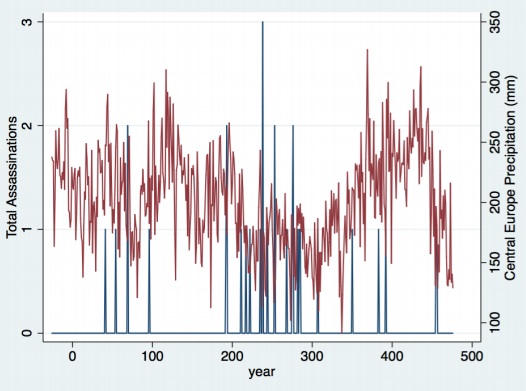Droughts of Dismay: Rainfall and Assassinations in Ancient Rome
By Cornelius Christian (Brock University) and Liam Elbourne (St. Francis Xavier University)
Abstract: We find that lower rainfall in north-central Europe (Gaul/Germania) predicts more assassinations of Roman emperors from 27 BC to 476 AD. Due to agricultural pressures on Germanic tribes, low precipitation caused more barbarian raids. These raids, in turn, weakened the Empire’s overall political stability, and reduced the costs of assassinating an emperor. We buttress our empirical analysis with case study evidence.
URL: http://d.repec.org/n?u=RePEc:brk:wpaper:1703&r=his
Circulated by nep-his on 2017/10/08
Review by Fernando Arteaga (George Mason University)
Summary
Was Imperial Rome’s political stability disturbed by environmental shocks? If so, what were the transmission channels? These are the two fundamental questions the authors aim to answer. Their thesis is straightforward: As any pre-industrial society, rainfall levels predicted agricultural output in Roman times. A lack of rain affected food availability, especially in the underdeveloped regions where Northern Germanic Tribes resided, making these societies more prone to raid Roman towns across the border. The incursions then created political conflict among the Romans themselves.

The text relies on econometric analyses and a couple of case studies to back up the argument. The main statistical test is simple: they regress Roman political stability on rainfall data. The main variable they use as a proxy of political unrest is the assassination of Roman emperors (as presented by Scarre 1995): the more emperors were killed, the less stability in the Empire. Alternatively, they also employ an index of inflation and new governmental infrastructure investment as a proxy for stability (larger inflation and less imperial projects imply improved stability). The rainfall variable comes from Buengten et al. (2011) own estimations on precipitation levels across France and Germany for all the period under study. Figure 1 displays the main data points used in the analysis. The authors find that negative rainfall shocks are both associated with more emperor’s being killed (Figure 2) and with having larger inflation rates and fewer investment projects. A decrease of one standard deviation in precipitation caused an 11.6% standard deviation increase in assassination probability. The regression is empirically valid because there is no possibility of reversal causality; precipitation is not a factor that may be influenced by Roman politics [1].

Figure 1: Roman Gaul/Germania (Yellow). Rainfall Datapoints (Green). Emperor Assassination Locations (Red)

Figure 2: The red line indicates the precipitation level, while the blue is the amount of Roman Emperors assassinated.
But how exactly does lack of rain destabilized Roman society? The paper’s hypothesis relies on the Germanic raid linkage: Germanic tribes attacked Rome when they had a poor harvest of their own, which then created unrest in Roman interior stability. To test such assertion, they regress Germanic/Gaul incursions on the rainfall levels. The raid data they use comes from Venning (2010), who reviewed the many times the Roman Empire suffered raids through its history. The authors find a negative correlation: a decrease in one standard deviation in rainfall is associated with a 4% standard deviation increase in a number of raids. They corroborate the results by doing some robustness tests: 1) a placebo test, in which they regress non-Germanic raids on precipitation levels, which they find that had insignificant impact (which means that precipitation mattered only in Germanic zones, because they were the only ones that really suffered from a lack of rain); 2) an instrumental variable where the relationship between Roman instability and Germanic incursion is instrumented by rainfall. They find that “a standard deviation increase in the raid dummy [the presence of raiding] causes a 29.3% increase in the probability of assassination.”
To give more weight to their results, they present a brief recapitulation on the reigns of two assassinated Roman emperors: Severus Alexander (208-235) and Gallienus (218-268). The key insight is that both emperors faced important challenges on the Eastern and Northern borders, however only the latter had a relevant impact on Roman internal politics. On the East, the Roman Empire frequently collided with the Sassanid Empire (the other larger state in the area), but notwithstanding the severity of the clashes (at some point they even captured a Roman Emperor, the father of Gallienus) it never caused great civil unrest in Rome. However, on the North, Rome bordered the Germanic tribes (scattered non-organized societies) that did affect Rome’s stability. The conclusion we get from the narrative is that the Germanic border was important/special precisely because it was very susceptible to environmental shocks, which then led to constant raiding; unlike the Sassanid border, in which the Romans faced a cohesive society that could successfully resist bad crops or confront military bravados on non-environmental factors.
Comment
I enjoyed reading the paper very much. It made me re-realize why I find Economic History fascinating: it deals with topics that are interesting in themselves (the politics of the Roman Empire! What is not to like about it?), that remain relevant for today’s problems (we still seek to understand the relationship between nature and political conflict very much), and it treats the issues under study with great care and humility (there is no grand universal theory, but a careful attempt to attain a reliable empirical finding- however small that is).
My main concern with the paper is that the authors never clarify the relationship between Northern Rome’s lack of state capacity and the barbarian incursions. The main narrative maintains that the Germanic raids were the source of Roman political unrest (that is the way I summarized the argument in the preceding section). But at several instances across the paper, the authors hint that Roman political complications in Gaul were themselves a precursory factor that made the Germanic incursions more menacing.
The problem is present in both the econometric analysis and in the case studies. If I understood it correctly (by looking at figure 1), the regressions they asses rely on data that captures rainfall in both Roman Gaul/Germania and non-Roman Germania. The argument is that lack of rain affected Germanic independent tribes more because they were less prepared than the Roman borderline towns. Intuitively, this sounds right. However, the assertion does not imply that alternative transmission channels could not matter too. Yes, Roman towns were better prepared to endure bad harvests than their Germanic neighbors, but that doesn’t imply that bad agricultural output in Roman towns could not be the cause of political instability in them. There may be a relevant omitted variable bias problem in the empirical specification. [2]
The problem seems clearer when we consider the conclusions the authors get from their case studies: in them, they compare the level of relevance local border town problems in Germania/Gaul and in Syria had on larger Roman politics. The Germanics were a constant thorn on Rome, but the Syrians weren’t. Why? The authors explicitly stress that Roman Gaul/Germania had lower state capacity than Roman territories next to Syria, and so it was easier to subdue unrest in Syria than in Gaul. However, if that is so, then we are led to beg the question of what causes what? Is weak state capacity due to raiding, or is raiding due to weak state capacity? The paper’s narrative emphasizes the former linkage (all of the quantitative estimations rely on that sole mechanism too) while, at the same time, it recognizes that the latter mattered too. Unfortunately, it never sets to disentangle the underlying causality. [3]
References
Buengten, Ulf et al. (2011) “2,500 years of European climate variability and human
susceptibility.” Science, 331(6017), pp. 578-582
Scarre, Chris (1995) Chronicle of the Roman Emperors: The Reign-by-Reign Record of the Rulers of Imperial Rome. Thames & Hudson: London.
Scheidel, Walter (2015) “Orbis: the Stanford geospatial network model of the Roman world.” http://orbis.stanford.edu/
Venning, Timothy. (2010) A Chronology of the Roman Empire, Bloomsbury Academic: New York.
Endnotes
[1] The authors confirm this by regressing rainfall at time t on lagged t -1 political stability. It is interesting to note that this obvious observation may not be true for current events. Climate change is indeed affected by the domestic politics of some countries.
[2] I also remain confused about what data was used for some of the alternative estimations. For example, on the placebo test, they regress non-Germanic raids on precipitation levels. I assume they are using non-Germanic precipitation levels too. Otherwise, it would mean they would be testing how rain in Germania affects raids in non-Germania, which would make no sense. However, they don’t clarify.
[3] My two cents on the Syrian/Gaul distinction is that geography and travel times may explain it. ORBIS (A project that reenacts the geospatial framework of the Roman Empire) allows us to estimate the times and cost of regular trips to different cities in the Roman Empire. A trip from Rome to Cologne would last 32 days on the fastest route and 63 days on the cheapest. A trip from Rome to Palmyra, on the other hand, would last 28 on the fastest route and 42 on the cheapest. This can provide a benchmark of the cost of mobilizing resources across regions: moving a Roman army could be 1/3 cheaper if it had to go to Syria rather than Germania. This significative figure implies that the costs of subduing unrest in Germania were larger and so more difficult.
